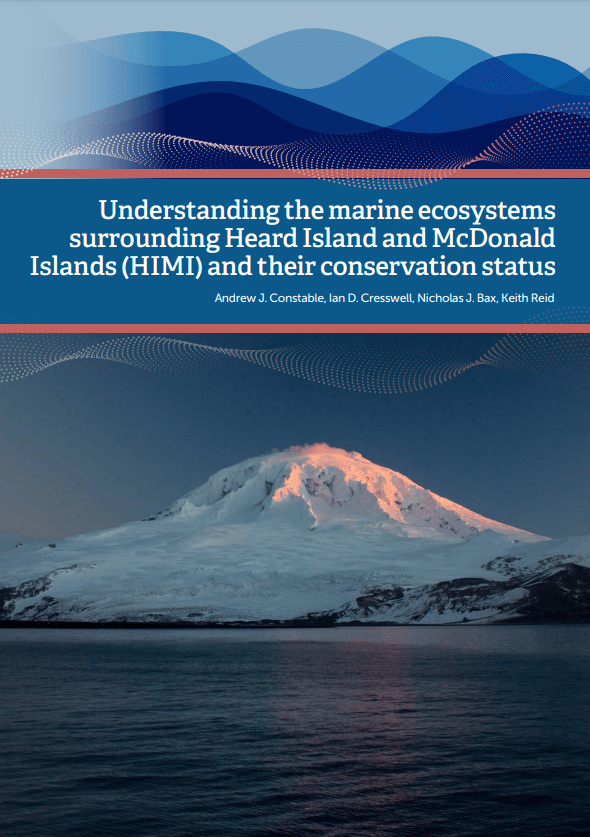Heard Island and McDonald Islands (HIMI) are a remote subantarctic island group located about 4,000 km south-west of Western Australia and approximately 1,700 km from the Antarctic continent.
The HIMI exclusive economic zone (EEZ) abuts the French EEZ around the Kerguelen Islands. The HIMI complex is part of the Kerguelen Plateau, which is a large submerged continental plateau that extends more than 2,000 km, with only a few emergent volcanic islands. Heard Island and McDonald Island are the two largest islands with the only two active volcanoes in Australia.
Recommendations
Scenario 1 – Ensure all six conservation areas are fully represented in The Reserve as IUCN Category 1a (strict nature reserve) under the EPBC Act.
This report demonstrates that all six Key Conservation Areas meet the criteria for inclusion in the NRSMPA and, as an integrated whole, they provide the most effective mechanism for the ongoing protection of the biodiversity in the region. Given the existing reserve is currently zoned IUCN Category 1a and the need to maintain the exceptional biodiversity values of the area, it is recommended to maintain the highest level of protection and assign IUCN Category 1a for reserve additions. Key Conservation Areas 1 to 5 are proposed for the protection of both benthic and pelagic biodiversity, while Key Conservation Area 6 is proposed to protect pelagic biodiversity and the maintenance of pelagic food webs (Figure 40). The incorporation of the first five Key Conservation Areas in the existing marine reserve would increase the total protected area coverage in the EEZ from 17% to 38% for combined benthic and pelagic habitats. The incorporation of Key Conservation Area 6 as IUCN Category 1a (strict nature reserve) would provide protection for a further 43% of the EEZ.
These additions to The Reserve will provide important protections of different benthic habitats across the entire depth range of the HIMI EEZ, as well as protection of pelagic food webs and important pelagic foraging areas. The inclusion of the Elan Corridor Conservation Area provides representation of different oceanography to that in the east and provides links to the subantarctic with colder waters around Elan Bank. The protection of the Western Plateau Conservation Area increases the representation of fish biodiversity, provides protection for the spawning grounds of Patagonian toothfish, as well as other areas of importance to pelagic food webs, and accounts for differences in benthic species between the west and the east of the HIMI EEZ.
Scenario 2 – Ensure five Conservation Areas are fully represented in The Reserve as IUCN Category 1a (strict nature reserve) and protect the South Pelagic Conservation Area as IUCN Category IV (habitat or species management area).
This report demonstrates that all six Key Conservation Areas meet the criteria for inclusion in the NRSMPA. It is recommended Key Conservation Areas 1 to 5 be zoned IUCN Category Ia for the protection of the benthic and pelagic conservation values. The South Pelagic Conservation Area is recommended for the protection of pelagic food webs and the foraging grounds of resident marine mammals and birds, particularly during the summer breeding season and could be reserved specifically for species management and zoned as IUCN Category IV (see Figure 41). Currently The Reserve only protects 13%, 9% and 25% of the foraging areas of macaroni penguins, king penguins and fur seals, respectively. This would increase to 37%, 30% and 63% respectively with the addition of Key Conservation Areas 1 to 5. This protection is much less than the 75% target level for the escapement of prey to provide for predators in the CCAMLR area. The incorporation of Key Conservation Area 6 as IUCN Category IV (for habitat or species management area) is recommended for the protection of pelagic food webs and the foraging grounds of resident marine mammals and birds, and would raise protection a further 43% of the EEZ from any activities that are not compatible with the conservation values of the reserve.
Given the need to protect the on-going ecological, biological, and evolutionary processes of the area as a key component of the Outstanding Universal Value of the HIMI World Heritage Area, it is essential that the main foraging areas of apex predators that rely on the Southern Pelagic Conservation Area (seals, penguins and flying birds) are adequately protected and it is recommended to be included in The Reserve under some form of protection.
